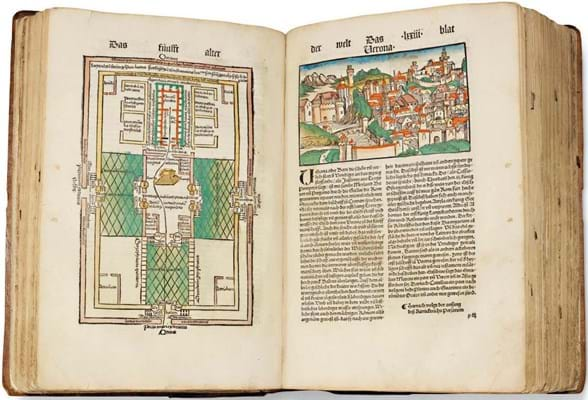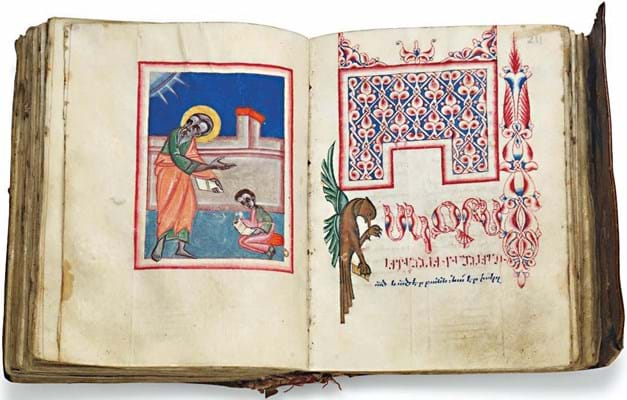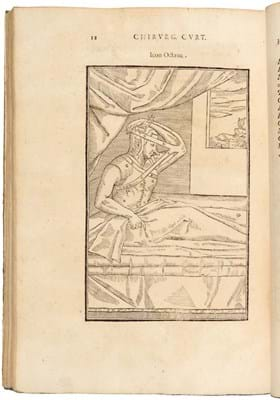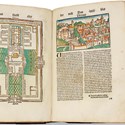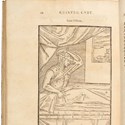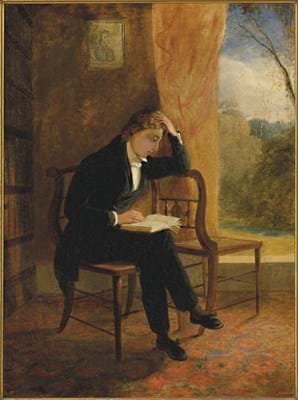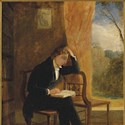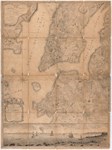From the Middle Ages to the Moon was the title given to a London sale that presented a wide-ranging assortment of books, manuscripts and even photographs that ranged in date from the 12th century to the present day.
Two of the rarer and more successful of 200 or so lots in that Christie’s (25/20/14.5% buyer’s premium) auction of April 14-28 were versions of Hartmann Schedel’s well-known Nuremburg Chronicle, or Liber Chronicarum.
Sold at £55,000 was a copy of Anton Koberger’s original and monumental 1493 edition that was once part of the library of Michael Abel, a Lutheran teacher and humanist poet who almost a hundred years later was appointed poet laureate by Rudolph II of Vienna.
That was a high-estimate result, but sold at £48,000 rather than the suggested £5000-8000 was a 1496, first edition in German of an abbreviated version of that famous work published as Das Buch der Croniken und Geschicten.
Translated by Georg Alt and printed by Johann Schönsperger in Augsberg, this edition with its simplified layout and smaller woodcuts was intended to be a more manageable and marketable version of the grand folio volumes of the original. Though showing some repairs and losses, the binding was a contemporary German one of elaborately tooled half calf over wooden boards.
Armenian gospels
Another notably more expensive than predicted lot to reach £48,000 was a decorated manuscript of 15th or 16th century Egyptian origin containing accounts of the lives of saints Filias, Philotheos, Mercurios and others, along with other Coptic devotional texts.
A third lot bid to that same level was an illuminated vellum ‘Four Gospels’ manuscript in the Armenian language.
Described as an attractive example of late Armenian illumination, dated 1703 and boasting what Sotheby’s called bold, formalised decoration and appealing miniatures painted in clear, bright colours, it was last seen in a Sotheby’s sale of 1990.
Specially bound for the dedicatee, the alchemist and Protestant activist Piotr Gorajski of Gora, a 1599 Prague first of Ogrod Krolweski (The Royal Garden) by Bartosz Paprocki made £22,000.
The work presents a historical chronicle of events in Poland and neighbouring areas of Moravia, what is now the Czech Republic and Slavic states, and is profusely illustrated with woodcut portraits of rulers, battle scenes and town views.
Heads in hands
Shown above are two very different works that share one curious similarity in the pose of the figure depicted.
On the left is a woodcut illustration from a very rare, example on large, thick paper of the 1597, first issue of Gaspare Tagliacozzi’s De Curtorum Chirurgia per insitionem, the first book devoted exclusively to plastic surgery. It sold for a low-estimate £35,000.
Seen next to it is one of two posthumously painted portraits of the poet John Keats made by Joseph Severn. Framed with a lock of his hair, it is the second of two such portraits that he painted of the poet who had died in his arms in Rome in February 1821.
Keats’ sufferings at the time, said Severn, were so dreadful that he would sometimes weep on waking to find himself still alive.
This second of those two portraits, in which the poet is seen with his head raised and his eyes open, rather than looking down at his book, was the one that Severn preferred and later chose to exhibit.
Once part of the extensive private collections of a former head of Sotheby’s book departments, the late Roy Davids (1942-2017), it was last seen at Bonhams in 2005, when in one of several Knightsbridge auctions of his collections – one focused on portraits of writers, artists and musicians – it realised £18,000.
On its return to the rooms this year it made £40,000.


